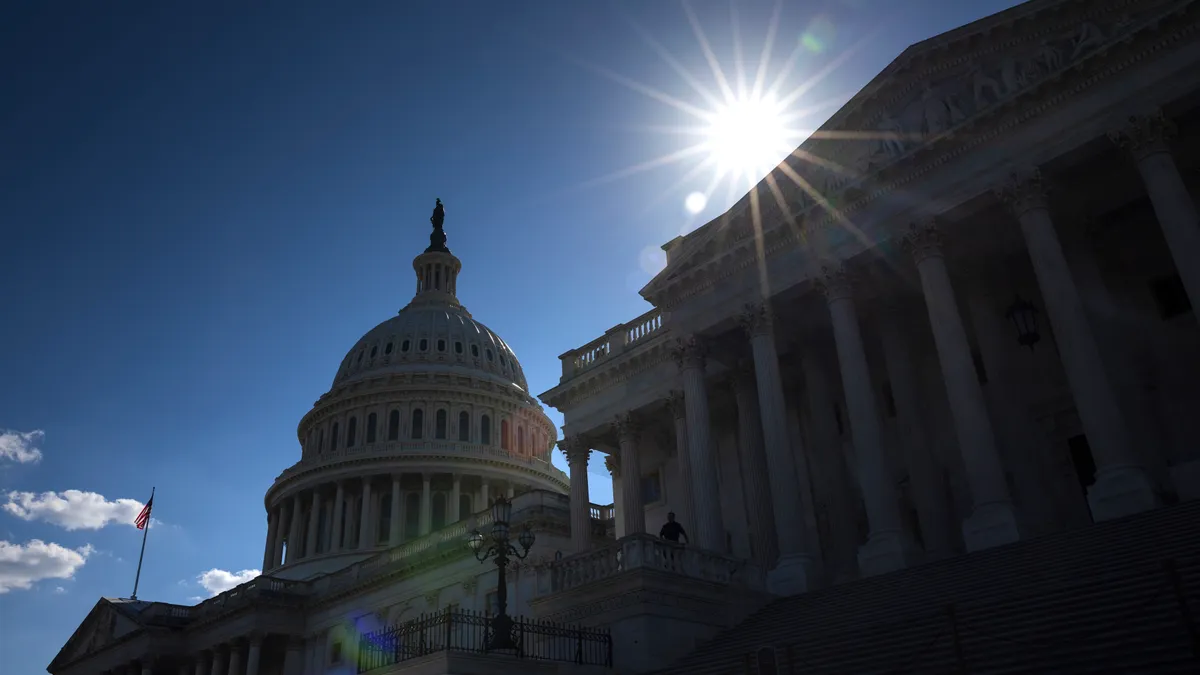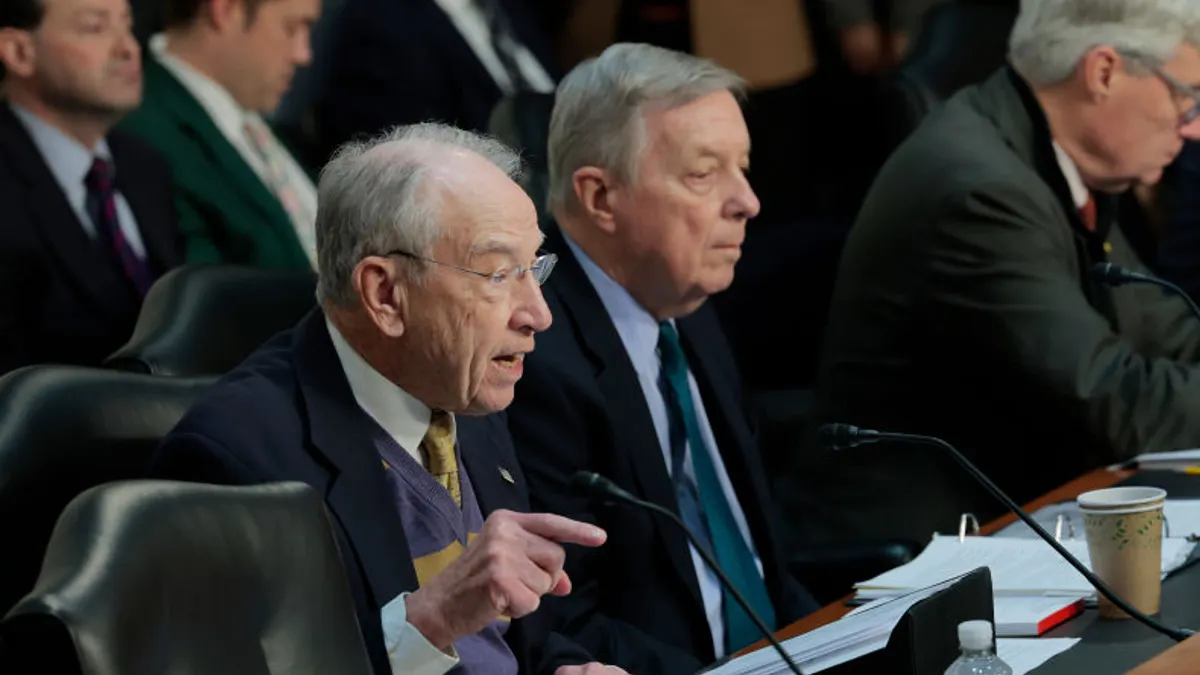This year has brought significant changes to the healthcare industry, ushered in by the Trump administration and the recently enacted “One Big Beautiful Bill Act.” Providers, insurers and health IT companies are looking ahead to Medicaid cuts, big changes to the Affordable Care Act and a reduction in funding for providers.
But, while major policy shifts work through the industry, other legislation from Congress hints at what providers, insurers and other stakeholders may have to brace for next.
Lawmakers in the House and Senate have introduced legislation aimed at reforming Medicare Advantage plans, overhauling transgender healthcare, cementing artificial intelligence in the sector, curbing some business practices of pharmacy benefit managers, equalizing payments between certain providers and more.
Some bills attempt to circumvent changes to healthcare policy made by the Trump administration, like those attempting to safeguard access to abortion and protect some ACA funding. Others try to cut government healthcare programs even further.
These are the top bills addressing core issues in healthcare this year.
340B
The 340B drug discount program was created more than three decades ago to help providers treating the most vulnerable Americans afford expensive drugs. Helping safety-net hospitals and clinics stretch scarce resources is a mission seemingly everyone can get behind. But for many critics – including drugmakers upset that 340B means lower profits and fiscal hawks concerned about snowballing spending — the program has mutated well beyond its original intent.
That’s put Congress in a bind, caught between calls to protect 340B on one side and to overhaul the program on the other. The disconnect is reflected in comments from lawmakers — but not in bills introduced this year, which would largely preserve the status quo or even grow the 340B program.
Early this year, Rep. Jack Bergman, R-Mich., reintroduced a bill with bipartisan support that would extend 340B discounts to rural emergency hospitals. And in July, Rep. Doris Matsui, D-Calif., and Sen. Peter Welch, D-Vt., introduced a bill called the 340B PATIENTS Act that would shield providers’ use of contract pharmacies to dispense 340B drugs.
It’s a major point of contention in the program: Before 2010, 340B providers could only contract with one outside pharmacy. But the HHS reversed the policy, causing the number of pharmacies in 340B to skyrocket from 1,300 in 2010 to more than 30,000 in 2025.
Investigations by the Government Accountability Office and members of Congress suggest this explosion has allowed improper dispensing to run rampant. Only half of contract pharmacies pass 340B discounts along to patients, and contract pharmacies are often located in wealthier areas that shouldn’t need savings from 340B, according to the Government Accountability Office.
Meanwhile, the 340B PATIENTS Act, if passed, would conflict with several federal court rulings limiting hospitals’ use of contract pharmacies in litigation brought by drugmakers. Still, the bill has strong support from hospitals, and is in line with several states that have passed laws stopping drugmakers from restricting hospitals’ use of contract pharmacies to dispense 340B drugs.
Bills introduced last Congress, including the 340B ACCESS Act, the 340B Transparency Act and a draft bill circulated by a bipartisan working group called SUSTAIN 340B, would put more guardrails around the program. Suggested policies include requiring hospitals to more directly funnel 340B savings along to patients; creating more transparency by forcing hospitals to report 340B data, like margins on discounted drugs; and preventing the unlimited use of contract pharmacies.
Pharmacy benefit managers
Lawmakers agree that something needs to be done about pharmacy benefit managers, but it’s less clear what steps they could take.
PBM reform was cut from a spending package at the end of 2024, and a flurry of bills this year lay out diverse policies meant to prevent the drug middlemen from profiteering off of their position in the U.S. pharmaceutical supply chain.
Bills introduced in 2025 would ask the Federal Trade Commission to investigate anticompetition in the PBM industry — already a focus of regulators — rope PBMs into lowering patients’ co-pays, and create more transparency and reporting requirements for the companies.
Other bills go further. In March, Senate Democrats sought to resuscitate PBM reform that fell victim to the previous Congress as part of a broader healthcare package, with no success. The legislation would have forced PBMs to pass through 100% of rebates to sponsors of prescription drug plans in Medicare and the group health market. It would also have prohibited the middlemen from billing Medicaid states and plans more for drugs than what they reimburse pharmacies, a controversial practice called spread pricing.
Banning spread pricing popped up in other legislation introduced this year, including the Protecting Pharmacies in Medicaid Act and the Pharmacy Benefit Manager Transparency Act — which would also stop PBMs from clawing back payments they make to pharmacies. Similarly, bipartisan bills were proposed to delink PBM compensation from rebates and stop PBMs from discriminating against independent pharmacies.
Reforming payments to PBMs could lower the country’s annual drug spending by nearly $100 billion, according to a USC Schaeffer Center analysis.
Medicare spending and Medicare Advantage
Medicare is reaching a tipping point. As the population skews older, more and more Americans are aging into the federal insurance program — but the number of workers contributing to its revenues are dropping. Meanwhile, more seniors are choosing privatized Medicare Advantage plans, which are more expensive for the government than traditional Medicare coverage.
The trends are threatening the future of the program, which currently covers more than 68 million Americans. Right now, Medicare is projected to go broke in 2033, at which point Medicare payments will be cut, affecting benefits.
Medicare experts say it’s well past time for Congress to step in to ensure the program’s stability, and legislators on both sides of the aisle have agreed there’s an urgent need for action. But bills introduced by Democrats this year would instead expand the program to cover more services, including hearing, dental and vision — popular policies but ones that could hasten Medicare’s insolvency. Democrats have also introduced bills, including the Medicare for All Act, that would establish a national health insurance program or allow more Americans to buy into the insurance program, in a bid to guarantee healthcare to U.S. citizens — political nonstarters in the Trump administration.
Medicare reforms with a greater chance of near-term passage revolve around MA or Medicare Part C, in which the government contracts with private payers to manage the care of Medicare beneficiaries. MA, which allows plans to offer more benefits than in traditional Medicare but also curtails provider networks and coverage, has grown to cover more than half of all Medicare seniors. However, the program has faced rising criticism of snowballing spending, coverage denials and unaddressed insurer fraud.
Bills introduced with bipartisan backing this year would stop MA plans from denying claims without consulting a relevant physician, make MA plans’ pre-authorization processes more efficient and transparent, and crack down on upcoding in MA, in which insurers exaggerate their members’ health needs to get higher payment.
On the flip side, another bill quietly proposed in May by a lone Republican congressman would mean a serious expansion of MA if passed. H.R. 3467 would automatically enroll millions of seniors in MA plans and lock them into those plans for three years.
Medicaid and the Affordable Care Act
Medicaid was at the center of healthcare reforms in the GOP’s tax and policy megabill signed into law in July. The so-called “One Big Beautiful Bill” creates new work requirements in the safety-net insurance program, prohibits certain state funding arrangements with providers and enacts other policies that are expected to slash federal healthcare spending by roughly $1 trillion.
Many such policies were present in bills introduced earlier in the year, including curtailing benefits for noncitizens, enacting work requirements and increasing Medicaid eligibility checks. Meanwhile, Democrats were introducing bills that would expand Medicaid benefits to more low-income Americans and guarantee continuous enrollment.
Some conservatives wanted deeper cuts in their reconciliation package, suggesting that Medicaid could not be out of the woods yet this year. Though, proposals like rolling back higher federal spending for Medicaid expansion populations would likely be a tough sell.
The Big Beautiful Bill also overhauled the ACA, shortening enrollment periods and heightening standards to qualify for coverage subsidies. The law stopped short of a full repeal — a step long pursued by conservatives, even over a decade after the ACA’s implementation.
Still, other legislation proposed by Republicans this year could further chip away at the ACA’s protections, including by exempting plans from maintaining minimum essential coverage and expanding skimpier alternatives to ACA plans, including short-term and association health plans. Meanwhile, Democrats have introduced a bill to enhance the ACA’s navigator program, which helps enrollees shop between coverage, after the Trump administration slashed funding for navigation earlier this year.
There may be some room for bipartisan movement on the ACA when it comes to punishing brokers who change enrollees’ ACA plans without their consent, a policy supported by both Democrats and Republicans.
Other health insurance-related bills introduced this year would expand the government’s authority to ensure plans offer comprehensive mental health coverage, require church-backed medical cost sharing schemes called healthcare sharing ministries to disclose more information about what they cover and give states more flexibility to adopt their own universal healthcare plans.
Violence against healthcare workers
Congress is considering two key bipartisan bills to address the rise in violence against healthcare workers. Healthcare workers are among the most likely to experience violence at work, with the Bureau of Labor Statistics finding healthcare workers were five times more likely to experience violence compared to other occupations.
The problem could be getting worse. In a 2024 survey, 8 in 10 nurses told National Nurses United that they’d experienced violence on the job within the past year, exacerbated in part by patients’ and caregivers’ frustrations over COVID-19 protocols and precautions.
Rep. Joe Courtney, D‑Conn., and Sen. Tammy Baldwin, D‑Wis., reintroduced the Workplace Violence Prevention for Health Care and Social Service Workers Act in April, which would direct the Occupational Safety and Health Administration to require covered certain employers — including hospitals, clinics and mental health facilities — to implement comprehensive workplace violence prevention plans. It’s the fifth time the bill has been introduced, with the first introduction dating back to 2018.
Meanwhile, lawmakers have also introduced the Save Healthcare Workers Act, which would make assaulting hospital personnel a federal crime with penalties of up to 10 years in prison, including harsher sentences when weapons are involved.
It’s not the first time lawmakers have weighed similar policies, but the issue has heightened support following high-profile violent incidents at hospitals this year, including an attack in Pennsylvania in February, in which the husband of a woman being treated at UPMC Memorial shot and killed a police officer and wounded five others. In the same month, a nurse in Florida had nearly every bone in her face broken during an assault by a patient.
Still, passage is far from certain. Workplace protections have been introduced several times without gaining traction, and implementation costs could be a barrier in this Congress, which has focused on cutting government spending.
Rural hospitals
Following the passage of the One Big Beautiful Bill Act, lawmakers have renewed focus on safeguarding rural health access.
Rural hospitals are confronting mounting threats to their solvency, including heightened risk of closure due to financial instability and rising uncompensated care costs.
Two bills aim to address these headwinds. The Rural Physician Workforce Production Act, reintroduced this year by Rep. Diana Harshbarger, R-Tenn., would boost Medicare payments to hospitals for residents who complete training in rural areas. The bill aims to strengthen the rural physician pipeline and address what hospitals say has been a long-term provider shortage. It’s the fourth time the bill has been introduced in Congress.
Meanwhile, the Fair Funding for Rural Hospitals Act would guarantee every state at least $20 million annually in Medicaid disproportionate share hospital payments for five years.
It’s unclear whether the bills will pass. Although the bills have support from the hospital industry and workers unions, both could face budgetary pushback. Raising minimum DSH allotments, for example, could be unpopular among some Republicans looking to cut spending. Still, lawmakers are already facing scrutiny from constituents about OBBA’s impending impact to rural providers, meaning there could be some political momentum to provide support to rural providers.
Site-neutral payments
In May, Sen. John Kennedy, R-La., introduced the Same Care, Lower Cost Act, which would require Medicare to pay the same rate for the certain outpatient services regardless of location, aligning with recommendations from the Medicare Payment Advisory Commission, a group that advises Congress on Medicare.
Supporters estimate the policy could save as much as $150 billion over the next decade, according to an analysis by the Congressional Budget Office.
However, hospitals strongly oppose the bill. The American Hospital Association argues that hospital outpatient departments face higher operating costs, due to factors including enhanced regulations and treating higher acuity patients.
The tension over site-neutral payments has been longstanding. Proponents for reform argue that site-neutral payments would save patients and Medicare money, and reduce incentives for consolidation. However, opponents say that without higher payments to hospital-owned facilities, rural hospitals might cut outpatient services altogether due to inadequate reimbursements.
Abortion/trans/social issues
On both sides of the aisle, lawmakers are introducing legislation attempting to enshrine their ideologies about healthcare access into law.
More than 30 anti-trans bills focused on healthcare have been introduced or passed this year in Congress, according to the Trans Legislation Tracker. The bills range from reducing federal funding for certain therapies to banning gender-affirming care treatments for minors altogether. Meanwhile, on the other side of the aisle, Democrats are fighting to preserve trans Americans’ access to healthcare, including through the Transgender Health Care Access Act, and prevent Medicaid funds from flowing to conversion therapy, with the Prohibition of Medicaid Funding for Conversion Therapy Act.
Lawmakers have also introduced a slew of policies centering on abortion access, with Democrats attempting to prevent Congress from cutting Medicaid funds for abortion providers and Republicans looking to defund Planned Parenthood, one of the largest providers of abortion services.
The legislation is likely symbolic on both sides, given the gridlock in Congress. However, the legislation signifies a deeply polarized landscape on what constitutes appropriate care. Providers can expect to operate in an increasingly politicized landscape where politicians seek to weigh in on best medical practices for a handful of flashpoint issues.
Artificial intelligence
AI is an exciting emerging technology for the healthcare sector, igniting hopes it could lessen the heavy burden of administrative tasks and ameliorate provider shortages.
However, regulation of the technology is relatively nascent — and the Trump administration has signaled it wants to prioritize speeding AI development.
Congress has also made some moves to guide the role of AI in healthcare. In April, Sens. Mike Rounds, R-S.D., and Martin Heinrich, D-N.M., introduced legislation that would develop a Medicare reimbursement pathway for AI-enabled medical devices approved by the Food and Drug Administration, an area where the agency has seen a significant growth in submissions in recent years.
Additionally, Rep. David Schweikert, R-Ariz., introduced a bill early this year that would make AI or machine learning eligible to prescribe medications.
Hospital at home and telehealth
During the COVID-19 pandemic, regulators loosened rules and created flexibilities to allow patients to access more care remotely.
Though some changes to Medicare telehealth policy have been made permanent, others are operating on temporary waivers and could expire without action from Congress.
In June, a bipartisan group of lawmakers reintroduced a bill that would remove the requirement that Medicare beneficiaries need to be seen in-person within six months of accessing mental and behavioral healthcare through telehealth. Some research has found telehealth expanded the number of people who received mental healthcare and treatment for opioid use disorder during the pandemic.
Additionally, a program enacted by the CMS that allows approved hospitals to offer acute level care at home could lapse without congressional action. In July, a bipartisan group of representatives and senators introduced a bill that would extend the hospital at home waiver through 2030.
Cybersecurity
Cybersecurity is a significant challenge for the healthcare sector, which has faced an increased wave of cyberattacks and data breaches in recent years — including the massive attack on UnitedHealth-owned Change Healthcare in 2024.
Though the Biden administration made some moves to boost cybersecurity in the industry, including setting voluntary goals for healthcare organizations and proposing an update to HIPAA, the issue hasn’t seen much action during the Trump administration.
Attacks can have serious consequences for providers, limiting access to critical technologies and forcing them to send emergency cases to nearby facilities. Meanwhile, healthcare organizations manage valuable and sensitive patient data, which can motivate hackers to target them.
In June, Rep. Brian Fitzpatrick, R-Pa., introduced legislation that aims to improve the federal government’s ability to respond to healthcare cyberattacks, requiring the Cybersecurity and Infrastructure Security Agency and the HHS to coordinate to identify potential threats.
The bill would also require CISA to put together cybersecurity training for providers and healthcare workers as well as direct the agency and HHS to conduct a study on specific vulnerabilities and risks in healthcare.






















